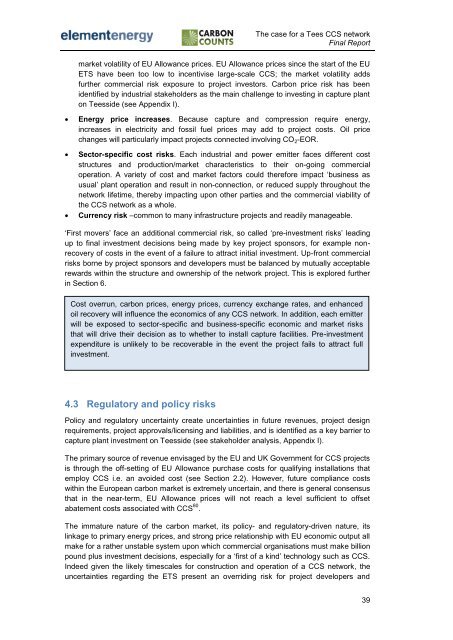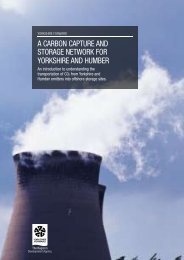Final report for One North East And NEPIC 21/12/10 - The Carbon ...
Final report for One North East And NEPIC 21/12/10 - The Carbon ...
Final report for One North East And NEPIC 21/12/10 - The Carbon ...
You also want an ePaper? Increase the reach of your titles
YUMPU automatically turns print PDFs into web optimized ePapers that Google loves.
<strong>The</strong> case <strong>for</strong> a Tees CCS network<strong>Final</strong> Reportmarket volatility of EU Allowance prices. EU Allowance prices since the start of the EUETS have been too low to incentivise large-scale CCS; the market volatility addsfurther commercial risk exposure to project investors. <strong>Carbon</strong> price risk has beenidentified by industrial stakeholders as the main challenge to investing in capture planton Teesside (see Appendix I).Energy price increases. Because capture and compression require energy,increases in electricity and fossil fuel prices may add to project costs. Oil pricechanges will particularly impact projects connected involving CO 2 -EOR.Sector-specific cost risks. Each industrial and power emitter faces different coststructures and production/market characteristics to their on-going commercialoperation. A variety of cost and market factors could there<strong>for</strong>e impact „business asusual‟ plant operation and result in non-connection, or reduced supply throughout thenetwork lifetime, thereby impacting upon other parties and the commercial viability ofthe CCS network as a whole.Currency risk –common to many infrastructure projects and readily manageable.„First movers‟ face an additional commercial risk, so called „pre-investment risks‟ leadingup to final investment decisions being made by key project sponsors, <strong>for</strong> example nonrecoveryof costs in the event of a failure to attract initial investment. Up-front commercialrisks borne by project sponsors and developers must be balanced by mutually acceptablerewards within the structure and ownership of the network project. This is explored furtherin Section 6.Cost overrun, carbon prices, energy prices, currency exchange rates, and enhancedoil recovery will influence the economics of any CCS network. In addition, each emitterwill be exposed to sector-specific and business-specific economic and market risksthat will drive their decision as to whether to install capture facilities. Pre-investmentexpenditure is unlikely to be recoverable in the event the project fails to attract fullinvestment.4.3 Regulatory and policy risksPolicy and regulatory uncertainty create uncertainties in future revenues, project designrequirements, project approvals/licensing and liabilities, and is identified as a key barrier tocapture plant investment on Teesside (see stakeholder analysis, Appendix I).<strong>The</strong> primary source of revenue envisaged by the EU and UK Government <strong>for</strong> CCS projectsis through the off-setting of EU Allowance purchase costs <strong>for</strong> qualifying installations thatemploy CCS i.e. an avoided cost (see Section 2.2). However, future compliance costswithin the European carbon market is extremely uncertain, and there is general consensusthat in the near-term, EU Allowance prices will not reach a level sufficient to offsetabatement costs associated with CCS 80 .<strong>The</strong> immature nature of the carbon market, its policy- and regulatory-driven nature, itslinkage to primary energy prices, and strong price relationship with EU economic output allmake <strong>for</strong> a rather unstable system upon which commercial organisations must make billionpound plus investment decisions, especially <strong>for</strong> a „first of a kind‟ technology such as CCS.Indeed given the likely timescales <strong>for</strong> construction and operation of a CCS network, theuncertainties regarding the ETS present an overriding risk <strong>for</strong> project developers and39







